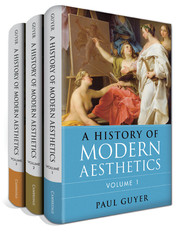Book contents
- Volume 1 The Eighteenth Century
- Volume 2 The Nineteenth Century
- Volume 3 The Twentieth Century
- Frontmatter
- Contents
- Acknowledgments
- Introduction
- Part One German Aesthetics in the Twentieth Century
- Part Two Aesthetics in Britain until World War II
- Part Three American Aesthetics in the First Half of the Twentieth Century
- 6 Santayana
- 7 The American Reception of Expression Theory I
- 8 Dewey
- 9 The American Reception of Expression Theory II
- 10 After Dewey and Cassirer
- Part Four Wittgenstein and After
- Bibliography
- References
6 - Santayana
from Part Three - American Aesthetics in the First Half of the Twentieth Century
Published online by Cambridge University Press: 05 June 2015
- Volume 1 The Eighteenth Century
- Volume 2 The Nineteenth Century
- Volume 3 The Twentieth Century
- Frontmatter
- Contents
- Acknowledgments
- Introduction
- Part One German Aesthetics in the Twentieth Century
- Part Two Aesthetics in Britain until World War II
- Part Three American Aesthetics in the First Half of the Twentieth Century
- 6 Santayana
- 7 The American Reception of Expression Theory I
- 8 Dewey
- 9 The American Reception of Expression Theory II
- 10 After Dewey and Cassirer
- Part Four Wittgenstein and After
- Bibliography
- References
Summary
George Santayana (1863–1952) inaugurated aesthetics as a major part of academic philosophy in the United States at the end of the nineteenth century and remained the most prominent writer on aesthetics in the United States in the first third of the twentieth, that is, until the appearance in 1934 of Art as Experience by his close contemporary John Dewey. While not part of the aestheticist movement – for example, he did not use the phrase “art for art’s sake” – Santayana did consider beauty, whether in nature or in art, an ultimate value, and indeed in his 1896 book The Sense of Beauty, his most enduring work, he held that beauty (and companionship in the enjoyment of it) is our only positive value, while the role of morality is negative: morality is concerned with the removal of evil, but even if all evil were removed, something to give positive value to life would still be needed and only beauty can do that. In Santayana’s words, “While æsthetic judgments are mainly positive, that is, perceptions of good, moral judgments are mainly and fundamentally negative, or perceptions of evil.... Morality is not mainly concerned with the attainment of pleasure; it is rather concerned, in all its deeper and more authoritative maxims, with the prevention of suffering.” But if morality were actually to be successful at eliminating suffering, then “the reign of duty” would have to give way “to the dispensation of grace” that comes from beauty. To be sure, Santayana recognized that in the present and foreseeable circumstances of human life, there is no likelihood that morality’s work of alleviating all human suffering actually will be done, so “the appreciation of beauty and its embodiment in the arts are activities which belong to our holiday life, when we are redeemed for the moment from the shadow of evil and the slavery of fear, and are following the bent of our nature where it chooses to lead us.”
- Type
- Chapter
- Information
- A History of Modern Aesthetics , pp. 238 - 264Publisher: Cambridge University PressPrint publication year: 2014



